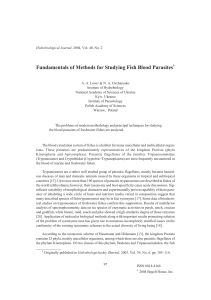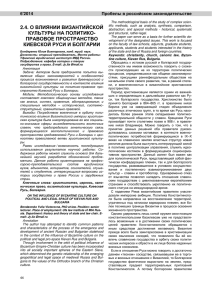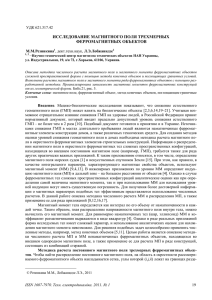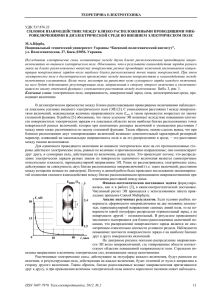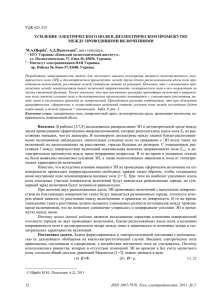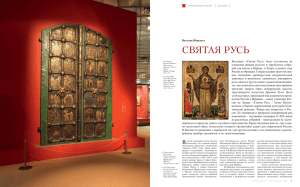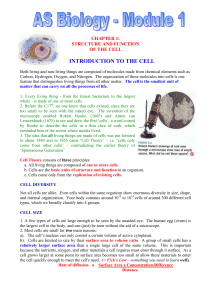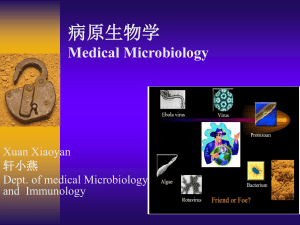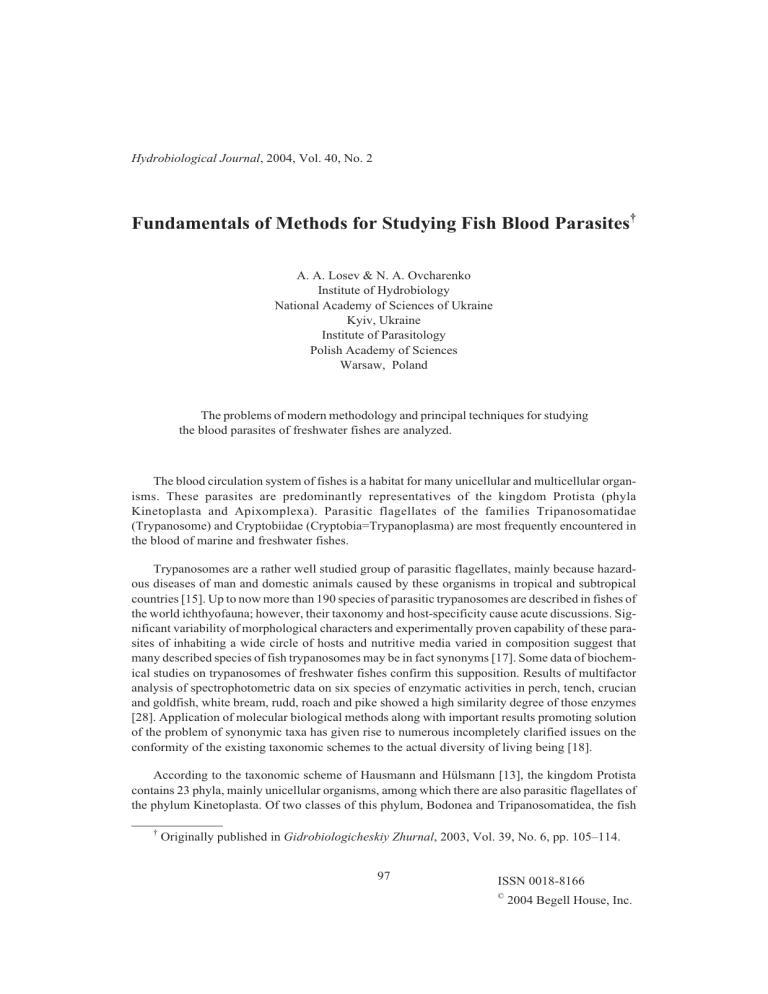
Hydrobiological Journal, 2004, Vol. 40, No. 2 Fundamentals of Methods for Studying Fish Blood Parasites† A. A. Losev & N. A. Ovcharenko Institute of Hydrobiology National Academy of Sciences of Ukraine Kyiv, Ukraine Institute of Parasitology Polish Academy of Sciences Warsaw, Poland The problems of modern methodology and principal techniques for studying the blood parasites of freshwater fishes are analyzed. The blood circulation system of fishes is a habitat for many unicellular and multicellular organisms. These parasites are predominantly representatives of the kingdom Protista (phyla Kinetoplasta and Apixomplexa). Parasitic flagellates of the families Tripanosomatidae (Trypanosome) and Cryptobiidae (Cryptobia=Trypanoplasma) are most frequently encountered in the blood of marine and freshwater fishes. Trypanosomes are a rather well studied group of parasitic flagellates, mainly because hazardous diseases of man and domestic animals caused by these organisms in tropical and subtropical countries [15]. Up to now more than 190 species of parasitic trypanosomes are described in fishes of the world ichthyofauna; however, their taxonomy and host-specificity cause acute discussions. Significant variability of morphological characters and experimentally proven capability of these parasites of inhabiting a wide circle of hosts and nutritive media varied in composition suggest that many described species of fish trypanosomes may be in fact synonyms [17]. Some data of biochemical studies on trypanosomes of freshwater fishes confirm this supposition. Results of multifactor analysis of spectrophotometric data on six species of enzymatic activities in perch, tench, crucian and goldfish, white bream, rudd, roach and pike showed a high similarity degree of those enzymes [28]. Application of molecular biological methods along with important results promoting solution of the problem of synonymic taxa has given rise to numerous incompletely clarified issues on the conformity of the existing taxonomic schemes to the actual diversity of living being [18]. According to the taxonomic scheme of Hausmann and Hülsmann [13], the kingdom Protista contains 23 phyla, mainly unicellular organisms, among which there are also parasitic flagellates of the phylum Kinetoplasta. Of two classes of this phylum, Bodonea and Tripanosomatidea, the fish † Originally published in Gidrobiologicheskiy Zhurnal, 2003, Vol. 39, No. 6, pp. 105–114. 97 ISSN 0018-8166 © 2004 Begell House, Inc. trypanosomes were referred to the second of classes, and these are representatives of a separate genus of the family Tripanosomatidae [13]. Karpov holds a similar opinion as to the position of trypanosomatids in the system of protists; he believes that trypanosomes and Cryptobia both belong to the phylum Kinetoplastidea. The macrosystem of the kingdom Protista developed by Karpov incorporates 32 phyla united into 15 superphyla [6]. Cryptobia, or Trypanoplasma, are known as causative agents of a hazardous disease of salmonids and cyprinids, thus inflicting a significant economic damage because of extensive death and changed commercial qualities of the affected fish. Clinical symptoms of cryptobiosis are anorexia, exophthalmia, splenomegaly, hepatomegaly, ascites, and anemia. Diseased fish suffer from acute oxygen deficiency, lose appetite and perish from asphyxia and emaciation. Pathological phenomena are accompanied by immune deficiency [11, 12]. More than 35 species of blood parasites belonging to this genus are described up to now. Intracellular parasitic protists of the family Haemogregarinidae (phylum Apicomplexa [13], or Sporozoa [6]) are encountered in the blood of freshwater fishes much more rarely than parasitic flagellates. Sporozoites, merozoites, microgametocytes and macrogametocytes of haemogregarinides can be detected at examination of stained blood smears. Of above 80 species of these intracellular parasites more than 15 species are known in freshwater fishes. Intermediate hosts of haemogregarinides, as well as in trypanosomides, are leaches. Extensiveness of infestation in marine fishes may exceed 70% [21]. Besides parasitic protists, flukes (Trematoda) belonging to the families Spirorhidae and Sanguinicolidae of the phylum Platyhelminthes (taxonomy following Price, 1967) being in the larval and sexually mature stages of development also may be rather rarely encountered in fish blood [5, 8, 20]. Main technical ways of obtaining the material for studying the blood parasites Fresh fish blood is used to detect blood parasites. It is most commonly obtained directly from the heart of a desensitized fish by a Pasteur pipette or sterile syringe [7]. The site of provided puncture has to be cleaned from the scales and slime and treated with an antiseptic before the procedure. One inserts the injection needle tilted towards the head between the pectoral fins. In recently died large fish, the blood is taken by a Pasteur pipette directly from the heart immediately after opening up of the abdominal cavity. To take the blood from the caudal artery, it is recommended to insert the Pasteur pipette by rotating motions under the angle of 45° behind the anus up to the contact with the vertebral column until the blood begins to come. The blood samples in fish yearlings and small fishes can be received by cutting off the caudal trunk. The blood sampled is brought on the clock glass from which it can be taken by a micropipette for further manipulations [3, 4]. The blood parasites are analyzed under maximal magnification of a microscope that makes extremely high demands of quality of the slides. Preparations made on slides thicker than 1.2 mm are badly fit for application of immersion [3]. It is recommended to maintain new slides in the saturated solution of potassium dichromate in concentrated sulfuric acid not less than 24 hours. After washing off these in running water for 1–2 hours, the slides have to be rinsed in distilled water, dried, and packed in containers. In order to avoid dirtying, the slides at manipulations should be taken with the pincers and hold only by their edges, without touching the working surfaces. Under laboratory con98 ditions, clean and degreased slides are kept in the mixture of absolute ethanol and ether (1:1) until their use [3, 4, 7]. To make a thin blood smear, a small drop of blood is applied to the end of a glass slide. A narrower polished slide is positioned in front of the drop at the angle of 45° and drawn back to the contact with the drop; the blood has to be spread between the end of the polished slide and the object-plate surface. The smear is made by a smooth movement. In correctly made preparations, the smear edge should end 1.5–2.0 cm from the opposite end of the slide [3]. A number of parasitic individuals in a blood specimen is, as a rule, not great, and because of that certain difficulties arise at analyzing those in stained smears. There are several methods for concentration of blood parasites. The simplest of these is introduction of a blood specimen into the test-tube, which is left in vertical position in the refrigerator. After the grume has been formed, floating parasites can be found in the remained plasma; these organisms are concentrated by centrifugation [17]. The method of blood fractionating in hematocrit capillaries is more effective [27]. Hematocrit capillaries treated with aquous heparin solution (1:10) are filled with blood (about 0.06 ml). One end of capillary is sealed with plasticine or another pressurizer (Critoseal). The capillary prepared in this way is centrifuged in a hematocrit centrifuge at 12000 rpm for about 4 minutes [17]. When using the capillaries of 0.1 ml in volume, duration of centrifugation should be prolonged to 10–15 minutes. After centrifugation, the capillary is placed on the microscope stage and, after applying several drops of immersion oil, examined under 100´ magnification. Motile parasites are localized at the boundary of leukocyte and blood plasma fractions. The capillary is broken if necessary, and the smear is prepared from the blood fraction that contain parasites. The method described has both undoubted merits (simplicity, possibility to obtain the data in a few minutes after the blood taking) and limitations, such as relatively low sensitivity (not less than 100 individuals per 1 ml of blood) and necessity for selection of a centrifugation regime for the specific host [24]. Other more complicated and precise methods of isolation of blood parasites are known, which are described in detail in relevant literature [16]. Developmental stages of parasitic flagellates from the intermediate hosts are studied in the smears of the gut content or in histological slides. In order to prepare the smears, the anterior and posterior suckers of a leech treated with an antiseptic are cut off, and the content of its the digestive tract are squeezed on the glass slide. Opening up and analyzing of the cardiac cavity is performed for detecting the flukes (Sanguinicola spp.) and microsporidians (Myxobolus (Myxosoma) cerebralis). The content is placed into saline and examined under a microscope. It is also possible to find flukes and microsporidians by analyzing the bloodstream in kidneys and gills and the brain [1, 2, 4, 5, 8, 10]. Fixation and staining of preparations Freshly prepared smears are dried in the air and fixed on histological glass with absolute methanol for 5–10 minutes. Fixation in the mixtures of absolute ethanol and ether (1:1) is also used. Fixed smears are stained with azure-eosin by Romanowski–Giemsa according to the standard procedure. The working solution of the dye is prepared immediately before the use. Success of staining depends on the purity of vessels and acidity of the staining mixture. The best results are achieved at pH 7.2; therefore it is recommended to prepare the working staining solution by dissolving the dyes in 99 the mixture of distilled water and 0.01M phosphate buffer (9:1). The mixture is controlled by a standard pH-meter, changing the acidity by adding drop by drop one of the constituents of buffer solution, if necessary. Immediately before staining, the mother dye solution is added to the prepared mixture on the basis of one drop of this solution per 1 ml mixture. The staining lasts for 20–30 minutes. After that, the preparations should be washed in distilled water. The rapidly acting method with the aid of the mixture for staining of blood (Hemacolor) by the Merck Company [9] also yields good results. For studying histopathology and identification of precise localization of parasites, the histological slides prepared from invaded tissues or whole individuals (leeches) are commonly used. The Bouin liquid is one of the best histological fixatives. If it is unavailable, 10% neutral formalin is used as the fixative of histological preparations. The slides are stained with iron hematoxylin by Heidenhain [19]. Other staining methods are also used [17, 23]. Preparation of material to study ultrastructure Knowledge of ultrastructure is of great importance in studying blood parasites. Transmission electron microscopy is used for studying the ultrastructural peculiarities of cells and organelles of parasites. The technique successfully approved at studying tripanosomids in the Laboratory of Parasitic Protists of the Institute of Parasitology of the Polish Academy of Sciences is given below [26]. Preparation of the materials for ultrastructural studies involves several stages. 1. Parasites are selected from the heparinized blood or cultural medium by centrifugation in a floatation solution. This is made by solving 5 g sodium chloride, 5 g glucose and 5 g sodium citrate in 0.5 L water. The blood is mixed with the floatation solution (1:10). Centrifugation lasts 15 min at a velocity of less than 1000 rpm. The selected upper portion of this liquid is centrifuged for 15–20 min at 2000 rpm. The residue has to be separated, and supernatant is inspected under a microscope; when parasites are discovered, the centrifugation has to be repeated at 2500 rpm. 2. The residues are mixed and fixed during 2–24 hours in 2.5% glutaraldehyde dissolved in 0.05 M cacodylate buffer (pH 7.4) with 0.12 M saccharose solution added at 4oC. 3. Fixed material is washed off for 1 hour in 0.05 M cacodylate buffer (pH 7.4) with 0.12 M saccharose added, and following 15 min in the same buffer containing no saccharose. 4. Postfixation is performed by maintaining the material in 2% OsO4 dissolved in 0.05 M cacodylate buffer (pH 7.4) for 2 hours at the temperature of 4oC. 5. After washing off (30–45 min) in 0.05 M cacodylate buffer without saccharose and in distilled water (10 min), the specimen is dehydrated in ethanol solutions of increasing concentration (50 %, 70 %, 80 %, 90 %, 96 % and 100 %) by 30 min in each. 6. The dehydrated specimens are hold in the mixture of absolute ethanol and propylene oxide (1:1) and in pure propylene oxide, 30 minutes in each. 100 7. The embedding mixture is prepared (4.5 g DDSA as a hardener and 4 drops DMP-30 as a plasticizer are added to 4.5 g mixture combined of Epon 812 and Araldite), and material is hold 2–4 hours in this mixture dissolved in propylene oxide following the scheme 1:3, 1:1, and 3:1. 8. Embedding of the material is performed by placing it in the pure embedding mixture where the step-by-step polymerization at 37°C for 24 hours, at 45°C for 12 hours, and at 56°C for 24 hours takes place. The mix formula of main components for fixation and making of preparations used for transmission electron microscopy is given in corresponding technical manuals [9, 23]. In the sequel, the hardened blocks are cut by an ultramicrotome, contrasted in solutions of uranyl acetate and lead citrate by Reynolds, and examined under a transmission electron microscope using accelerated voltage of 60–80 kV. The preparing of the object for its investigation under a scanning electron microscope involves fixation of the specimen, its dehydration and evaporation with carbon, gold or platinum [29]. After the material is fixed with glutaraldehyde and osmium tetroxide and dehydrated by absolute acetone, the object should be dried in a special device by its rapid freezing at the critical point. After that, the material applied on the surface of the object stage covered with sizing agent is subjected to vacuum evaporation. Methods of cultivation of blood parasites The flagellates parasitizing the fish blood can be effectively cultivated in vivo and in vitro. The goldfish Carassius auratum auratum is the most suitable object for in vivo experimentation [16]. Also other, free of parasites, fish species are employed. The fish is infected by inteperitoneal inoculation of blood or cultural liquid containing the parasites. Success of infection depends on purity of instruments, investigator’s experience, and quality and quantity of the invasive material. A dose of 1000–2000 parasite individuals is considered as quite sufficient for infection [11, 19]. The content of the gut of leeches treated with antibiotics can also be used as an invasive material. The fish infected is investigated weekly, starting from the second week after the infestation. The blood for analyzing is sampled by heart puncture or excision of a small piece of gill tissue. The same invasive material is used for in vitro cultivation by placing it in test-tubes or special cultivators filled with nutritive media. Good results are obtained by using of the SNB 9 two-phase medium. This medium consists of a solid phase, Neopepton Difco (2g) + Bacto agar Difco (2 g) +NaCl (0.6g), and a liquid phase, Neopepton Difco (2g) + NaCl (0.6g) [17, 19, 22]. The components of each phase have to be dissolved in 100 ml distilled water and autoclaved at the temperature of 120°C. One adds 25 ml sterile defibrinated human or rabbit blood to the constituents of the first phase at 45–50°C, and cooling is going on. 2 ml cultivation medium are introduced into the cultivation test-tube 13 mm in diameter by means of a warmed pipette, and the tube sloped under some angle is fixed in the thermostat at about 12°C. 0.25 ml vitamin-mineral mixture [17, 19], 0.2 ml solution containing 200 units of penicillin and 0.15 ml streptomycin sulphate solution (150 mg/L) are added to 100 ml cooled mixture constituting the liquid phase. 0.5 ml (for Tripanosomide) or 2.0 ml (for Criptobia) liquid phase and 0.1–0.2 ml invasive inoculate are applied on the solid phase layer immediately before its use. A cultivation temperature depends on the species of parasite and is usually 18–25°C. The stages of parasites developing in the culture are only poorly stained with standard 101 dyes. Such smears are fixed in the mixture of methanol and alcoholic iodine solution (5:1) during 5 minutes [25]. After drying, the smears are subjected to hydrolysis in 1 N HCl solution at 60 °C for 2 minutes. After this, the smears are rinsed with the neutral buffer solution and stained by Romanowski-Giemsa. For a long conservation of invasive material, the blood specimens are subjected to the cryoconservation in liquid nitrogen. Dimethyl sulfoxide is used as a cryoprotector [22]. The blood is mixed with the cryoprotector up to concentration of about 10% , and the mixture is gradually cooled at a rate of approximately 1°C/min down to the temperature of -30°C. After cooling, the material is placed in liquid nitrogen. Methods for analyzing the preparations of parasitic flagellates Judging from the literature and our own experience, it can be stated that in water bodies of Ukraine, as well as in whole Europe, the parasitic flagellates belonging to the genera Trypanosoma and Cryptobia (Trypanoplasma) are most frequently detected in fish blood [1–3, 10]. The basic methods described above enable establishing with certainty the presence of these blood parasites. To analyze them, it is necessary to identify the host fish species, morphological, dimensional and biological (polymorphism, capability of developing in cultures and in a variety of hosts) characters of parasites, infection intensity and extensiveness of host. Determination of morphological parameters of trypanosomes and cryptobians are the most important part in the analysis of blood parasites. Present-day researchers use for that a microscope coupled with a video camera and computer provided with image recognition software (Analysis Pro 2.11 or any other similar software). The set enables highly accurate (up to 0.001 µm) express measurements and statistical analysis of morphological dimensions peculiar of the object, which are impossible at applying an ordinary ocular-micrometer. The Microsoft Excel application is used for statistical processing of dimensional parameters. Morphological characterization of parasites, including data on the dimensions, is performed according to the protocol presented in Fig. 1. In order to unify the data reported in domestic and foreign literature, dimensional parameters in trypanosomes and cryptobians are given in conformity with their designations in English as those are applied by Hoare [14]. A distance from the anterior to the posterior end along the body axis (a) is the body length of parasite (BL, body length). The body width (b) is measured in its broadest part, excluding the height of the undulating membrane (W, body width). Localization of the cell nucleus is an important taxonomic character; it is determined by measuring a distance from its center to the anterior pole of parasite’s body (a’’) (NA, nucleus centre to anterior end) and a distance from the nucleus center to the posterior pole of spore (a’) (PN, posterior end to nucleus centre). PN/NA ratio is characterized by the NI index (nucleus index). The parameter when NI=1 means a central localization of the nucleus in the cell; at NI<1 the nucleus is situated closer to the posterior end of the cell; respectively, NI>1 indicates that the nucleus is in a forward position. The nucleus length, N (nucleus) is also often measured. 102 Fig. 1. A scheme for measurements of trypanosomes and cryptobians [17] (modified): a, body length; a', distance from the nucleus centre to the posterior body end; a'', distance from the nucleus centre to the anterior body end; b, maximal body width (measured along the line passing across the central body axis, including its bends); c, length of the fore flagellum; d, length of the free portion of the flagellum; e, distance from the kinetoplast center to the posterior body end; f, distance from the kinetoplast center to the nucleus center. The kinetoplast position is determined as a distance from its center to the nucleus center (f) (KN, kinetoplast to nucleus centre) and to the posterior body end (e) (PK, posterior end to kinetoplast). The KI index (kinetoplast index) corresponds to PK/KN ratio. A value KI=2 means that the kinetoplast is halfway between the nucleus and the posterior end of the cell; KI<2 indicates a more posterior localization of the kinetoplast; KI>2 means that the kinetoplast is placed closer to the nucleus. Trypanosomes have the flagellum, which, passing backwards along the cell, is connected with it by the undulating membrane, while its free end protrudes over the anterior end of the cell. Cryptobians have two flagella: the anterior (free), and posterior (attached) one (see Fig. 1). For characterizing the flagellar apparatus of trypanosomes, it is to measure the length of free portion of flagellum (d) (FF– free flagellum) and the total body length along the undulating membrane up to the posterior end of the flagellum (L) (total length). The flagellum index, FF/BL, is a ratio of the flagellum length to the length of parasite’s cell. In cryptobians, the length of the anterior free flagellum is also measured. Taking into account a high variability of morphological characters in many parasitic flagellates, all measurements needed for obtaining statistically significant data should be performed at least in 100 individuals. The arithmetic average (arithmetic mean), standard deviation, and limits of variability have to be calculated for each character. Photomicrography is the best method for documentation of data obtained at the treatment of preparations. A high-quality photograph informs about the shape and dimensions of a blood parasite, enables studying the localization of its organelles: the latter have to be measured by the preliminarily calibrated photographs. Such picture serves as a voucher for preparing the illustrations. The latter should reflect the most peculiar positions of parasites in the slides, as well as to show as good as possible the diversity of dividing and vegetative stages (see Fig. 2). The most modern and convenient documentation method is the use of image-processing computer software for images obtained immediately under a microscope by a microscanner. 103 Fig. 2. Morphological forms of Trypanosoma carassii registered in the circulatory bed of roach. Literature Cited 1. Bauer, O. I., Yu.L. Strelkov, V. M., Nikolaeva & V. A. Musselius. 1977. Ikhtiopatologiya. (Ichthyopathology.) Moscow, Pishchevaya Promishlennost Press. 23–186 pp. [Rus.] 2. Dogel, V.A. 1962. Obshchaya parazitologiya. (General parasitology.) Leningrad, Leningradskiy Universitet Press. 72–243 pp. [Rus.] 3. Ivanova , N. T. 1983. Atlas kletok krovi ryb. (Atlas of blood cells of fishes.) Moscow, Pishchevaya Promishlennost Press. 76 pp. [Rus.] 4. Ivanova, N. T. 1976. A method for morphological analysis of the blood in ichthyopathological studies. Pp. 175–177 in: Problemy izucheniya parazitov i bolezney ryb. (Problems in studying parasites and diseases of fishes.) Izvestiya GosNIORH 105. [Rus.] 5. Kapustin ,V. F. 1955. Atlas parazitov krovi zhivotnykh. (Atlas of animal blood parasites.) Moscow, Nauka Press. 27–32 pp. [Rus.] 6. Karpov, S. A. 2000. Sistema protistov. (System of the protists.) 3rd ed. St. Petersburg. Omsk, Omskiy Ped. Universitet Press. 215 pp. [Rus.] 7. Kudryavtsev, A. A., L. A. Kudryavtseva & G. I. Privol’noye. 1969. Gematologiya zhivotnykh i ryb. (Hematology of animals and fishes.) Moscow, Kolos Press. 320 pp. [Rus.] 8. Markevich, A. P. 1951. Parazitofauna presnovodnykh ryb Ukrainskoy SSR. (Parasitic fauna of freshwater fishes of the Ukrainian SSR.) Kiev, AN USSR Press. 375 p. [Rus.] 104 9. Ovcharenko, N. A. 2002. New and modified methods of investigation of microsporidians in aquatic animals. Gidrobiologicheskiy Zhurnal 38(1): 62–72. [Rus.] 10. Bykhovskiy, B. E., ed. 1967. Opredelitel’ parazitov presnovodnykh ryb SSSR. (Keys of the parasites of freshwater fishes of the USSSR.) Leningrad, AN SSSR Press. 772 pp. [Rus.] 11. Ardelli, B.F. & P.T.K. Woo. 2002. Experimental Cryptobia salmositica (Kinetoplastida) infections in Atlantic salmon, Salmo salar L.: cell-mediated and humoral immune responses against the pathogenic and vaccine strains of the parasite. J. Fish Dis. 25(5): 265–274. 12. Bahmanrokh, M. & P. T. K. Woo. 2001. Relationships between histopathology and parasitaemias in Oncorhynchus mykiss infected with Cryptobia salmositica, a pathogenic haemoflagellate. Dis. Aquat. Org. 46: 41–45. 13. Hausmann, K. & N. Hülsmann. 1996. Protozoology. 2nd Ed. New York, Thieme Medical Publisher. 338 pp. 14. Hoare, C. A. 1972. The trypanosomes of mammals. Oxford, Edinburgh, Blackwell Scientific Publications. 321 p. 15. Kreier, Y. P. & Y. R. Baker. 1987. Parasitic Protozoa. Wellington, London, Sydney: Allen & Unwin. 241 p. 16. Lanham, S. & D. G. Godfrey. 1970. Isolation of salivarian trypanosomes from man and other animals using DECE cellulose. Exp. Parasitol. 28: 521–534. 17. Lom, J. & I. Dyková. 1992. Protozoan parasites of fishes. Amsterdam, London, New York, Tokyo: Elsevier. 315 p. 18. Patterson, D. J. 1994. Protozoa: Evolution and Systematics. Pp. 1–14 in: Hausmann, K. & N. Hülsmann (eds.) Progress in Protozoology. (Proc. of the IX Intern. Congr. of Protozoology, Berlin, 1993). Stuttgart, Jena, New York: Gustav Fischer Verlag. 19. Pecková, H. & J. Lom. 1990. Growth, morphology and division of flagellates of the genus Trypanosoma (Protozoa, Kinetoplastida) in vitro. Parasitol. Res. (7): 553–558. 20. Price, C. E. 1967. The phylum Platyhelminthes: a revised classification. Rivista di Parassitologia 28: 249–260. 21. Siddall, M. E. & S. S. Desser. 2001. Developmental stages of Haemogregarina delagei in the leech Oxytonostoma typica. Can. J. Zool. 79: 1897–1900. 22. Tailor, A. E. R. & J. R. Baker 1987. In vitro methods of parasite cultivation. London: Acad. Press. 465 pp. 23. Undeen, A. H. & J. Vavra 1997. Research Methods for Entomopathogenic Protozoa. Manual of Techniques in Insect Pathology. London: Acad. Press. Ch. IV. Pp. 117–151. 24. Very, P., R. Bocquentin & G. Duvallet. 1990. Sensibilité de la double microcentrifugation pour la recherche des trypanosomes. Rev. Élev. Méd. Vét. Pays Tropic. 43(3): 325–329. 25. Wallace, F. G. 1962. Trypanosomatid parasites of horse fleas with description of Crithidia rileyi n. sp. J. Protozool. 9: 53–58. 26. Wita, I. & N. Kingston. 1999. Trypanosoma cervi in red deer, Cervus elaphus, in Poland. Acta Parasitol. 44(2): 93–98. 27. Woo, P. T. K. 1969. The haematocrit centrifuge for detection of trypanosomes in blood. Can. J. Zool. 47: 921–923. 28. Zajícek, P. 1991. Enzyme polymorphism of freshwater fish trypanosomes and its use for strain identification. Parasitology 102: 221–224. 29. Zizka, Z. 1983. A comparison of changes in the volume of microsporidian and neogregarine spores using various methods of preparing spores for inspection with the scanning electron microscope. Acta Protozool. 22: 267–272. 105
